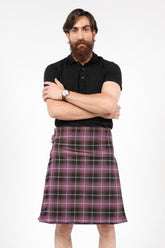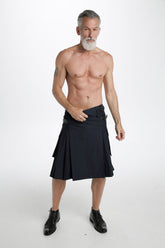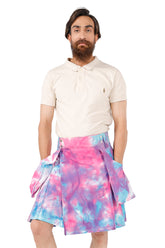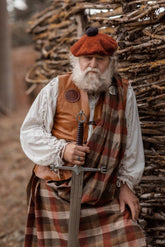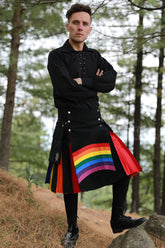Kilt vs Skirt: The Differences & Similarities
What is Kilt?
A kilt is a traditional Scottish garment that originated in the 16th century. Typically worn by men, it is a knee-length skirt like garment made of woolen fabric, often plaid or tartan, and secured with a belt. They are emblematic of Scottish culture and are associated with formal occasions like weddings or cultural events. They feature pleats at the back, providing both style and flexibility. They symbolize Scottish pride and heritage, with each clan having its distinct tartan pattern. While historically part of military attire, modern kilts have evolved into a versatile and iconic piece of traditional dress, cherished globally for their rich history and distinctive aesthetic.
What is a Skirt?
A skirt is a versatile garment, typically worn by women, that hangs from the waist and covers the lower part of the body. It comes in various lengths, styles, and fabrics, allowing for diverse fashion expressions. They can be A-line, pencil, pleated, or flared, catering to different occasions and personal preferences. They are a fundamental element of women's fashion, offering comfort and style. They can be paired with various tops, blouses, or jackets to create elegant or casual ensembles. This classic wardrobe staple has transcended cultural and historical boundaries, evolving with fashion trends while remaining a timeless symbol of femininity.
Are Kilts a Skirt?
Kilts, while resembling skirts, hold distinct cultural and sartorial significance. Rooted in Scottish tradition, they are tailored garments typically worn by men, Mens Kilt is characterized by their unique tartan patterns and pleated design. Unlike skirts, kilts are secured with specific accessories such as sporran and pin, reflecting their utilitarian purpose. Historically associated with Scottish clans and military regiments, they symbolize heritage and pride. While both of them share a draped aesthetic, kilts are a masculine and symbolic garment, embodying tradition and identity. Understanding the nuanced differences between them is crucial for appreciating the cultural heritage embedded in these distinctive apparel choices.
What is the Difference between Kilt & Skirt?
Both hold cultural significance and timeless elegance in the world of fashion. Despite their apparent similarity, there's a common misconception about the interchangeability of both. The origins of kilts and skirts trace back to diverse locations such as the rugged terrains of Scotland and Ireland and the ancient sands of Egypt. These garments have played pivotal roles in the lives of people across various cultures and time periods. Let's explore the differences between them:

Cultural & Historical Significance:
Both of them hold significant cultural and historical significance, each playing distinct roles in history and culture. Kilts are knee-length non-bifurcated garments traditionally worn by men in Scotland, origin of the kilt is deeply rooted in Scottish tradition and associated with specific tartan patterns representing clans or regions. Historically, they were used by the Scottish Army for protection and mobility during combat. On the other hand, skirts, typically worn by women, have a more universal presence and are adaptable to various occasions and fashion trends. While they are often perceived as formal wear for events like weddings or ceremonies, they maintain a flexible position in the wardrobe, absent of the ceremonial gravity often ascribed to kilts.
Design and Length:
Kilts and skirts have distinct differences in design and length. Kilts are traditionally made of twill-woven worsted wool with heavy pleats at the sides and back. The pleat length is determined by the tartan pattern, which is an important aspect of their design. They are knee-length, non-bifurcated pleated tartan. On the other hand, skirts are designed for practicality, comfort, and style, and come in various styles and materials. They have no specific pleat requirement and can be worn at different lengths, catering to different preferences and occasions. Understanding these differences is important in appreciating the cultural and gender-specific significance of these garments.
Gender Association:
Kilts, rooted in Scottish tradition, are often worn by men as a symbol of heritage and pride. They exude a sense of masculinity and are historically tied to warriors and clans. On the other hand, Skirts, prevalent in various global cultures, are predominantly associated with women's fashion. Although both garments have a similar overall shape, their distinct gender associations underscore the intricate relationship between clothing, culture, and identity.
Wearing and Accessories:
Kilts and skirts, despite their visual similarities, differ in their cultural contexts and accompanying accessories. Kilts, deeply embedded in Scottish heritage, feature a distinctive sporran and kilt belt—a decorative front pouch that combines style with practicality. This accessory enhances the overall aesthetic. In contrast, Skirts are worn by women and can be paired with various accessories such as underskirts, petticoats, and crinoline.
Functions to wear:
Kilts, deeply rooted in Scottish heritage, are traditionally worn during formal events like weddings and Highland gatherings, symbolizing pride and identity. They also have military associations, serving as part of formal uniforms. Skirts, on the other hand, have multifaceted functions in women's fashion, ranging from casual everyday wear to formal and professional settings. They adapt to diverse styles and occasions, providing a versatile option for social, work, and leisure environments. Understanding the specific functions of both enhances appreciation for their role in cultural expression and personal style.
Similarities between Kilt & Skirt!
Kilts and skirts are both garments that wrap around the waist, but there are some key differences between them. Here are some similarities between them:
Both wrapped around the waist:
Both are garments that wrap around the waist and cover the lower half of the body. They are typically made of fabric and can be tailored in length, fabric, color, material, cut, and style.
Both have a similar appearance:
In terms of appearance, they are very similar. Kilts are knee-length, non-bifurcated that have pleats at the back, while skirts can vary in length from above the knee to mid-calf or longer. However, it is important to remember that the kilt is entirely knee-length, while a skirt may be shorter or longer.
Discover the Rich Heritage of Kilts and Skirts Today!
Delve into the captivating legacy of kilts and skirts at Fashion Kilt. Our collection seamlessly merges tradition with contemporary style. Experience the richness of heritage when you choose to buy kilt, meticulously crafted for quality and authenticity. Discover the perfect balance of classic and modern aesthetics, ensuring Fashion Kilt remains your top destination for premium kilts. Elevate your wardrobe with our exquisite collection, where the essence of heritage harmonizes with the allure of contemporary fashion.
In conclusion, kilts and skirts are both garments that wrap around the waist and cover the lower half of the body. They have distinct differences in their cultural and historical significance, design, gender association, and accompanying accessories. Kilts, rooted in Scottish tradition, are knee-length, non-bifurcated pleated tartan traditionally worn by men, while skirts are more universal and adaptable to various occasions and fashion trends, predominantly worn by women. Both garments have unique features and styles, with kilts made of specific materials and patterns, and skirts offering a broad range of styles and materials. In terms of function, kilts are often perceived as formal wear for events like weddings or ceremonies, while skirts have multifaceted functions in women's fashion, ranging from casual everyday wear to formal and professional settings.
FAQs
What is the history behind kilts and skirts?
Kilts have a long history in Scotland and Ireland, dating back to the 16th century, where they were worn as a practical garment for outdoor activities like hunting and fishing. Skirts, on the other hand, have been worn by both men and women throughout history, with evidence of their use dating back to ancient civilizations like Egypt and Greece.
How do kilts and skirts differ in terms of appearance and usage?
Kilts are strictly knee-length, typically worn by men of Scottish and Celtic heritage at social events, exhibitions, or fairs. On the other hand, skirts can vary in length, fabric, color, material, cut, and style, and are often associated with women's clothing, worn at any time and on any occasion.
Can a kilt be considered a type of skirt?
Technically, kilts are a specific type of skirt that men wear, particularly in Ireland and Scotland. These traditional outfits are known as kilts. Modern skirts are worn by women and can be found anywhere.
Are there structural differences between a kilt and a skirt?
Kilts are more like rectangles that get wrapped around the waist and pinned/belted into place, whereas a skirt is a circle sewn together and completely closed, which you just slip on like a pair of pants. Kilts are a specific type of lower body wrap, typically worn by men, while skirts come in a wide variety of structural designs.
What are some popular styles of skirts?
Skirts come in a wide range of styles, including A-line, pencil, maxi, midi, mini, skater, wrap, and more. Each style has its own unique cut, length, and shape, making it suitable for different occasions and body types.

